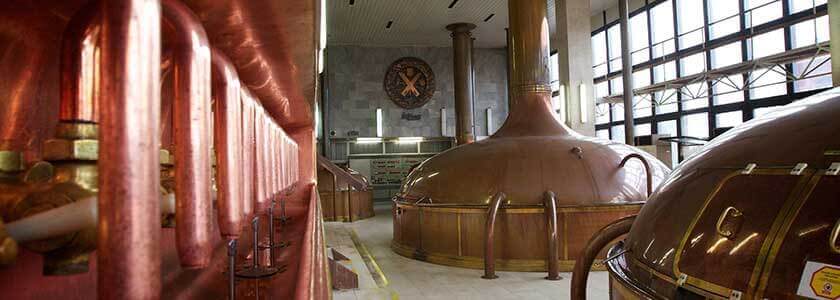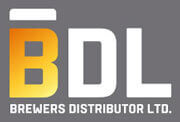BREWERS’ DISTRIBUTOR ACHIEVES QUICK ROI WITH LANSA
Brewers’ Distributor Ltd. (BDL) is Western Canada’s leading distribution and container return service for the brewing industry, moving nearly a billion dollars worth of beer per year. After successfully extending its JD Edwards system with LANSA-based web self-service and M2M integration for its wholesale customers, BDL used Visual LANSA Framework and LANSA Integrator as part of a dispatch and Warehouse Automation System that is saving them nearly $500,000 per year.
Andrew Hobbs, manager of IT applications at BDL, says, “We should see payback in less than three years. The total capital required to complete this project was $1.3 million and the annual savings are projected at over $450,000, not yet including the soft benefits of effective performance measurement and reduced error rates. Without LANSA we could not have achieved the look and feel necessary for this application, nor could we have implemented it in the short development window available to us on this project.”
We should see payback in less than three years.
- The Challenge
- The Solution
- The New Workflow
- The Benefits
- Future Improvements
- Company and System Information
The Challenge
BDL handles warehousing and distribution for its two shareholders, the Labatt and Molson breweries, which together hold over 85 percent of the Canadian beer market. Customers create on average 28,000 orders per month, an increasing number of which are handled electronically by a LANSA-based M2M solution that lets high-volume customers transmit orders directly from their POS systems and a self-service website used mainly by smaller customers. Read Brewers’ delivers better customer service with LANSA
Having streamlined and enhanced customer service, BDL’s next focus was to improve productivity in its Vancouver distribution facility that processes over 40 percent of the billion dollars BDL ships each year.
Picker productivity was hampered by inefficient procedures. Pickers delivered pallets to one of the six manual scales, introduced a few years ago to compare the actual and calculated weight of pallets. The picker would wait for a loss prevention officer to manually weigh, wrap, label and stage the pallet for shipping. Only then did the picker move on to his next assignment.
Hobbs explains, “Pickers would lose between 5 to 15 minutes for each pallet assignment. In our Vancouver distribution center, where we put through 1300 to 1700 pallets per day with 40 pickers, that could easily add up to over 100 lost man-hours per day.”
Another area open for improvement was the way pick slips were dispatched. Pick slips were printed in advance, manually sorted by priority and placed on a table for pickers to execute. Unfortunately some pickers would go through the stack of pick slips and take the easier looking assignments or more than one assignment at a time, disrupting the priority.
“We wanted to put control of the workflow into the hands of the supervisors. They needed better visibility of what still needed to be picked and better tools to manage that work,” continues Hobbs.
“We had already benefited from LANSA’s productivity and easy integration with JD Edwards when we delivered the web order system in 2004. Rather than introducing yet another technology that we would have to master and support, we decided to extend our investment in LANSA.”
Pickers would lose between 5 to 15 minutes for each pallet assignment.
The Solution
With the help of Samuel Strapping Systems, BDL designed and implemented an automated production line in their Vancouver distribution center that automatically weighs, wraps and labels completed pallets, then scans pallets as they move through the production line and are loaded onto delivery trucks.
Although this removed the delay at the manual scales, additional functionality and tighter integration with JD Edwards was needed to provide better management of the workflow.
“We took the new process well beyond just automating production lines,” says Hobbs. “We built a Warehouse Automation System (WAS) that uses a number of LANSA components. I strongly favoured web services for any system integration, as it fits in our plan to gradually move to a SOA environment. We used LANSA Integrator SOAP web service requests to have JD Edwards communicate with our line control software, Red Prairies labor management and other systems.”
“Last but not least we re-introduced Red Prairies’ labor management software and integrated this with WAS as well.”
“We began development of WAS in December 2005 and started the roll out late-April 2006, less than 5 months later. The project team consisted of four business-experienced RPG developers, who were newly trained in Visual LANSA. From time to time, we also had a LANSA Service Consultant on site who mentored our developers.”
“We could not have achieved the look and feel necessary in this application using traditional JD Edwards/RPG programming, nor could we have implemented in the short development window available to us on this project. The Visual LANSA Framework lets us easily and rapidly deliver content rich, flexible and easy to use applications to our user base.”
The developers really enjoyed working with LANSA. They were proud of the graphical systems they produced and of how quickly they did it. Development time has been cut significantly by using LANSA versus RPG. Not only that, the screens are highly graphical and intuitive, something we could not have done in RPG.”
The Visual LANSA Framework lets us to easily and rapidly deliver content rich, flexible and easy to use applications to our user base.

The New Workflow
The new Dispatch system lets dispatchers select customer orders for dispatch using a variety of filter options, for example by route, by geographical territory, or by customer. Selected orders are passed to a pick slip management program, which breaks down the order into pallets, each of which becomes a single picking assignment.
Once the orders are marked for dispatching, the Load Plan module lets the supervisors see each order at pallet level and sequence the pallet picking assignments according to priority and alter this priority to handle unforeseen events such as the unavailability of a truck.
Pickers go to a kiosk and swipes their ID-card, which triggers printing of the next pick slip and WAS passes pick slip data to the Red Prairie CALM system, which calculates a picking goal time which is displayed on the kiosk screen and on the printed pick slip.
The picker brings his loaded pallet to one of five in-feed lifts on any of the three automated lines and the pallet label and the pick slip are scanned. This ties the pallet ID to the pick slip order data and LANSA Integrator processes SOAP transactions that indicate to WAS the completion of the picking assignment and the start of the pallet’s journey on the production line.
“The line control software in our Vancouver distribution center interfaces using LANSA Integrator with the JD Edwards and WAS systems in our Calgary Data Center. The automated lines have scanners at different points along the line that read pallet labels and send the captured data via XML SOAP requests. Using LANSA Integrator, we receive and evaluate that data and send SOAP instructions back. The line control software does not move the pallet until WAS sends back a LANSA Integrator SOAP request to do so.”
“For example, if a pallet does not fall within the acceptable weight tolerance, we hold that pallet at the scale and report the variance to the process controller. The process controller can then either reject the pallet or allow it to continue to the next position on the line with an adjustment for inventory shortage or other overrides.”
The line control software in Vancouver does not move the pallet unless our Calgary system sends a SOAP request to do so.
The Benefits
“The total capital required to complete this project, including the Samuel Strapping line automation, was $1.3 million and projected annual savings are $450,000,” says Hobbs.
“We should see payback in less than three years. Above that, savings from effectively measuring and managing picker performance and reduceing error rates, is something that will become more evident over time.”
“We took away manual weighing, wrapping and labeling of product and replaced it with an automated line process. Now pickers drop off their finished pallet onto the line, scan it and go get the next order. We can now handle an additional 280 pallets in a 24 hour shift, a 25 percent improvement.”
“In the manual system we hired up to six loss prevention officers from an external security company for each eight hour shift. These have been replaced by three automated lines and one process controller,” says Hobbs.
“The new system gives us an accurate, timely overview of the daily workload and lets us release pick slip assignments in the most efficient order,” adds Peter Gill, warehouse manager at BDL’s Vancouver facility. “It gives us the control we need to manage the picking assignments properly based on our daily priorities, rather than leaving decisions to the individual picker.”
“Before we could not accurately measure picker productivity and didn’t have any reliable statistics to help set safe productivity expectations. We struggled allocating our existing resources wisely. We will be putting safe productivity expectations in place that take into account the layout of the warehouse and other rules set by specialized labor engineers and our own employees. We went from a system where we couldn’t effectively control work being done to one where we have detailed and reliable statistics.”
“Three months after going live, we reduced picking errors to three percent, the lowest ever at the Vancouver location. Correcting errors is expensive and impacts the performance statistics upon which our shareholders measure us,” says Hobbs.
Annual savings are projected at over $450,000.

Future Improvements
“Over time I can see our JD Edwards World system being phased out. Our version has been so highly customized that it is not really JD Edwards anymore, so upgrading would be a daunting task,” concludes Hobbs.
“We may move to the LANSA ERP Framework Code Start offering. With WAS we have already proven we can rapidly develop new and enhanced systems with LANSA. Our in-house developed web extensions and warehouse automation system give us a competitive edge, far and above the standard ERP logic. Using LANSA’s industry standard web services to integrate these diverse systems gives us a good start on the road to SOA.”
We have proven that we can rapidly develop new systems with LANSA.
Company and System Information

- Brewers’ Distributor Ltd (BDL), headquartered in Calgary, Alberta Canada, is a joint venture company owned by Labatt Breweries of Canada and Molson Breweries for the wholesale distribution of beer and the collection of returnable beer containers within Canada’s Western Provinces, as well as the Northwest Territories. BDL operates nine distribution centers and four cross-dock facilities.
- BDL won the LANSA America’s Customer of the Year award in 2006.
- For more information visit: http://bdl.ca/
- BDL uses a single System i model 550 with multiple locations attached via VPN connections and Citrix servers.
- BDL’s LANSA systems integrate with JD Edwards World V7.3.11 ERP software from Oracle, automated production line systems from Samuel Strapping Systems and computer assisted labor management software from RedPrairie. For more information visit: www.oracle.com,www.samuelstrapping.com and www.redprairie.com

